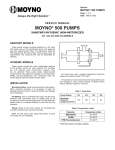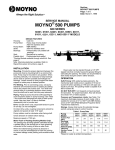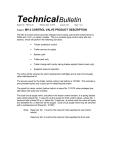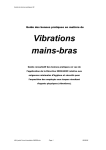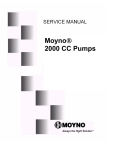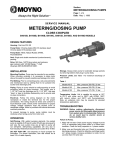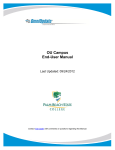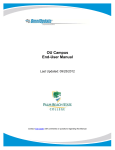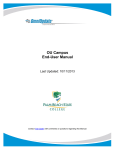Download Moyno® Metering/Dosing Pump :: Service Manual
Transcript
Section: METERING/DOSING PUMP Page: 1 of 4 Date: May 1, 1998 SERVICE MANUAL METERING/DOSING PUMP BARE SHAFT A4015A, A4100A, AND A4190A MODELS DESIGN FEATURES Housings: Cast iron/stainless steel Pump Rotor: Chrome plated 416 and 316 stainless steel Pump Stator: Nitrile, Natural Rubber, EPDM, Fluoroelastomer Shaft: 416 SS/316 SS Bearings: Prelubricated, fully sealed ball bearings Seal: Single or double mechanical seals, packing Flexible Joint: Prelubricated and sealed INSTALLATION Mounting. Provide the proper alignment between the pump and drive by mounting both to a common flat base. Pump may be mounted in any position. When mounting vertically, it is necessary to keep bearings above seals to prevent possible seal leakage into bearings. Loosen screws on body support and stator support to rotate pump to desired position. Pre-Wetting. Prior to connecting pump, wet pump elements and mechanical seal or packing by adding fluid to be pumped into suction port. Turn shaft over several times in a clockwise direction when viewed from the shaft end to work fluid into pump elements. Storage. Always drain pump for extended storage periods using pipe plug in suction housing. Pressure Limits. See Table 1 for maximum discharge pressure of each model. Table 1 Models 4015 Max. pressure 300 PSI, 20 bar Models 4100 Max. pressure 300 PSI, 20 bar Models 4190 Max. pressure 175 PSI, 12 bar Piping. Piping to pump should be self-supporting to avoid excessive strain on pump housings. The suction port is 1-1/2" NPT and the discharge port is 1-1/4" NPT. Use pipe “dope” or tape to facilitate disassembly and to provide seal. Temperature Limits. Unit is capable for service at 10°F to 210°F with nitrile, and to 260°F with EPDM, 185°F with natural rubber, and 350°F with fluoroelastomer. Note, an undersize rotor may be required for elevated temperature applications. Drive. On belt driven units, adjust belt tension to point of non-slip. Do not overtighten. TROUBLESHOOTING – Pump rotation must be clockwise when facing shaft. WARNING: Before making adjustments, disconnect power source and thoroughly bleed pressure from system. Failure to do so could result in electric shock or serious bodily harm. – Check direction of rotation before startup. Failure to Pump. – Maximum speed is 1750 rpm. 1. Belt or coupling slip: Adjust belt tension or tighten set screw on coupling. 2. Wrong rotation: Rotation must be clockwise when facing shaft. 3. Excessive suction lift, vacuum or obstruction in suction piping. 4. Flexible joint broken; possible excessive pressure: Replace joint, check pressure at discharge port. On direct drive units, coupling components should be aligned and spaced at least 1/16" apart. OPERATION Self-Priming. With wetted pumping elements, the mechanical seal model pump is capable of 15 feet of suction lift when operating at 1750 rpm with pipe size equal to port size. DO NOT RUN DRY. Unit depends on liquid pumped for lubrication. For proper lubrication, flow rate should be at least 10% of rated capacity. Will Not Start. 1. Insufficient horsepower: Check motor starting torque for minimum model starting torque given on performance curves. 2. Low voltage: Check power supply. Page 2 Noisy Operation. PUMP DISASSEMBLY 1. Starved suction: Check fluid supply, length of suction line, and obstructions in pipe. 2. Bearings worn: Replace parts; check alignment, belt tension, pressure at discharge port. 3. Broken flexible joint: Replace part; check pressure at discharge port. 4. Insufficient mounting: Mount to firm base. Vibrationinduced noise can be reduced by using mount pads and hose on suction and discharge ports. WARNING: Before disassembling pump, disconnect power source and thoroughly bleed pressure from system. Failure to do so could result in electric shock or serious bodily harm. Pump Overloads. 1. Excessive discharge pressure: Check discharge pressure for maximum rating given in Table 1. Check for obstruction in discharge pipe. 1. Disconnect power source. 2. Remove suction and discharge piping. 3. Discharge coupling (9) may be removed from stator (21) by unscrewing in a counter-clockwise direction (RH thread). 4. Remove stator support clamp screw and remove top half of stator support (38). 3. Belt or coupling slip: Check pressure at discharge port. 5. Stator (21) may be removed from suction housing (2) by unscrewing in a counter-clockwise direction (RH thread).Use a strap wrench on stator to avoid crushing with a pipe wrench. Pull stator (21) from rotor (22). To assist removal of stator, hold drive shaft (26) from turning and turn stator clockwise when facing suction housing after disengaging thread. 4. Loose bond in stator: High temperature and caustics will cause bond between rubber and tube to fail. Replace stator. Check fluid temperature and pressure at discharge port. 6. Remove screws (112) holding suction housing (2) to bearing housing (1) or adapter (74). Remove suction housing and suction housing gasket (83). Gaskets on cast iron models only. Remove O-Ring (270) on other models. 5. Fluid viscosity too high: See chart below for recommended maximum RPM. 7. The rotor (22) and flexible joint (24) may be removed using the following procedure (do not bend joint more than 15 degrees). 2. Excessive temperature. Viscosity CP Limit RPM 1-1,000 1750 1,000-2,500 1200 2,500-5,000 600 5,000-10,000 300 10,000-20,000 175 20,000-50,000 80 Based on 60% min. volumetric efficiency. See PEC449 for exact values. 6. Motor connected incorrectly: Motor wired for 230 VAC, connected to 115 VAC service. Poor Performance. 1. Low pressure; worn stator: Replace stator: Check for excessive abrasive material in fluid. Check for run dry condition. Mechanical Seal Leakage. 1. Leakage at startup: If leakage is slight, allow pump to run several hours to let faces run in. 2. Persistent seal leakage: Faces may be cracked from freezing or thermal shock. Replace seal. a. Remove rotor (22) from flexible joint (24) by using a punch to remove rotor shaft pin (46). Support joint while removing pin. b. Remove joint (24) from shaft (26) by using a punch to remove shaft pin (46). 8. Single Mechanical Seal Models. Carefully slide mechanical seal (69) off shaft (26). Carefully pry seal out of bearing housing (1), or seal housing (3). Remove seal housing if pump is a stainless model. Double Mechanical Seal Models. Carefully slide seal housing (71) from the drive shaft. Remove rotational part of mechanical seal from the shaft. Carefully remove seal gland (73) from adapter. Remove stationary seal faces if required. If any parts of mechanical seal are worn out or broken, the complete assembly should be replaced. Seal components are matched parts and are not interchangeable. Packing Models. Slide stuffing box assembly from the shaft. Remove packing gland halves and replace packing. 9. The bearings (29) and shaft (26) assembly can be removed from bearing housing (1) after snap ring (66) has been removed. To remove the shaft assembly, lightly tap the shaft at the flexible joint connection end using a block of wood to protect the shaft. The bearings may be pressed off the shaft. Pump Will Not Prime. PUMP ASSEMBLY 1. Air leak on suction side: Check pipe connections. Suction lift over 15 ft. will cause seal faces to open. 1. Press bearings (29) on shaft (26), and locate slinger ring (77) on the shaft near the radial bearing. 2. Defective mechanical seal: Inspect and repair as necessary. NOTE: When replacing bearings, always press on the inner race when assembling to shaft, and on the outer race when pressing bearings into the housings. MAINTENANCE General. These pumps have been designed for a minimum of maintenance. The pump is one of the easiest to work on in that the main elements are very accessible and require few tools to disassemble. Bearing Lubrication. The prelubricated, fully sealed bearings do not require additional lubrication. 2. Press shaft assembly into bearing housing (1) securing with snap ring (66). 3. On stainless steel models install seal housing (3) in bearing housing with O-Ring (270) installed in the O-Ring groove, on cast iron pumps. On packing models install stuffing box assembly (stuffing box, packing, and packing gland) on shaft with O-ring (270) installed in the O-ring groove. Page 3 6. Secure suction housing gasket (83) (cast iron pumps only) and suction housing (2) to bearing housing (1) using lockwashers (215) and screws (112). 4. Install mechanical seal (69) or (70) using the following procedure: a. Clean and oil sealing faces using a clean light oil (not grease). 7. Slide stator support retainer (39) on stator (21). CAUTION: Do not use oil on EPDM parts. Substitute glycerin or soap and water. 8. Screw coupling (9) on stator (21) in a clockwise direction (RH thread). b. Oil the outer surface of the seal seat, and push the assembly into the seal bore in the bearing housing (1), or seal gland and housing, seating it firmly and squarely. On double seal models install seal gland on shaft. NOTE: Apply pipe “dope” on all pipe threads before assembly. 9. Lubricate rotor (22) surface to assist installation of stator (21). Slide stator on rotor, and screw into suction housing (2) by turning clockwise (RH threads). An additional assist in installing stator is to lock the shaft from turning and rotate the stator counter-clockwise while pushing towards suction housing. c. After cleaning and oiling shaft, slide the seal body along the shaft until it meets the seal seat. d. Install seal spring and spring retainer or seal housing with O-rings (72 and 270) on shaft. 10. Secure clamp assembly (40) to the stator support (38) and the support retainer (39) using the clamp assembly (40) screw. 5. The flexible joint (24) and rotor (22) may be installed using the following procedure (do not bend joint more than 15 degrees): 11. Proceed as in installation instructions. WARNING: Replace belt or coupling guards before reconnecting power. a. Pin flexible joint (24) to shaft (26) using the shaft pin (46). b. Pin rotor (22) to joint using rotor pin (46). Support joint while installing pin. When ordering parts, please specify pump model number, pump serial number, part number, part description and quantity: Packing Models Double Seal Models 74 73 75 70 71 270 79 76 78 3 220 66 29 270 72 26 37 1 83 Stainless Steel Single Seal Models 215 112 2 300 69 46 40 39 22 9 Cast Iron Single Seal Models 26 77 21 261 24 38 Page 4 BARE SHAFT MODELS PARTS LIST Item 1 1 2 2 3 9 9 21 21 21 21 22 22 24 24 24 26 26 26 26 29 37 38 39 40 46 66 69 69 69 69 69 69 70 70 70 71 72 73 74 75 76 77 78 79 83 83 83 112 215 220 261 261 270 270 270 300 Type CD SS CD SS SS CD SS Q R B F CD SS Q, R B F CD SS CD SS CD/SS CD/SS CD/SS CD/SS CD/SS CD/SS CD/SS Q, R B F Q, R B F Q, R B F CD/SS Q, R, B, F CD/SS CD/SS CD/SS CD/SS CD/SS CD/SS CD/SS Q, R B F CD/SS CD/SS CD/SS CD SS Q, R B F CD/SS Description Bearing Housing Bearing Housing Suction Housing Suction Housing Seal Housing, Single Discharge Coupling Discharge Coupling Stator Stator Stator Stator Rotor Rotor Flexible Joint Flexible Joint Flexible Joint Drive Shaft Drive Shaft Extended Drive Shaft Extended Drive Shaft Bearing Body Support Stator Support Sta. Sup. Retainer Clamp Assembly Rotor/Shaft Pin Snap Ring Mechanical Seal Std. Mechanical Seal Std. Mechanical Seal Std. Mechanical Seal AR Mechanical Seal AR Mechanical Seal AR Double Mechanical Seal Double Mechanical Seal Double Mechanical Seal Seal Housing, Double O-Ring Seal Gland, Double Adapter Packing Set Stuffing Box Slinger Ring Packing Gland Half Stud Housing Gasket Housing Gasket Housing Gasket Screw Lock Washer Shaft Key Drain Plug Drain Plug O-Ring O-Ring O-Ring Name Plate ( ) Packing and Double Seal Models Req. 1 1 1 1 1 1 1 1 1 1 1 1 1 1 1 1 1 1 1 1 2 1 1 1 1 2 1 1 1 1 1 1 1 1 1 1 1 1 1 1 1 1 1 2 2 1 1 1 4 (8) 4 (8) 1 1 1 1 1 1 1 A4015A 3403923104 3403923204 3403923304 3403923504 3403927007 3403927015 PUMP MODELS A4100A 3303550000 3308813000 3403932001 3403932007 3403930007 3205341020 3205342020 3403924104 3403924204 3403924304 3403924504 3403928007 3403928015 3308811001 3308811003 3308811005 3303577001 3303577002 3311004001 3311004002 6300503031 3403947001 3403945001 3201733000 3204277000 and 3201734000 3204069001 3205162000 3202424000 3206379000 3206501000 3206460000 3206502000 3206503000 3208652000 3208652001 3208652002 3403986015 3207902128 3403985015 3501688004 3403396002 3403934007 3206382000 3403933007 3208591000 3203028001 3203028003 3203028005 6191520141 6230010401 6110030180 6100120031 6100420030 3207902134 3207904134 3207905134 3208597000 A4190A 3403925104 3403925204 3403925304 3403925504 3403929007 3403929015 Note: For further information, call 800-845-1310 (Western USA) 800-325-1331 (Central & Eastern USA), or 937-327-3553 (Ohio) © 1998 by Moyno, Inc. ® Moyno is a registered trademark of Moyno, Inc. Moyno, Inc. is a Unit of Robbins & Myers, Inc. Printed in U.S.A 320-8593-000 Double The Length Of Your Moyno Pump Warranty For FREE! For your free pump warranty extension, choose from one of the three options below: 1. Go to www.moyno.com and fill out the registration form online 2. Mail this form by placing it in an envelope and sending it to: Moyno, Inc. Attn: Tish Wilson P. O. Box 960 3. Fax this form to 937-327-3177 Springfield, OH 45501-0960 U.S.A. Thank you for choosing a Moyno Pump. Please take the time to complete this warranty registration form.Upon receipt of your form, your standard limited warranty on defective material and workmanship will be extended to twice the standard period of time at no additional cost to you. We appreciate your business and look forward to serving you in the future. MOYNO ™ Always Insist on Genuine Moyno Replacement Parts! Moyno® Pump Warranty Registration Pump Model # Pump Serial # Purchased From Date Purchased Your Name Your Title Your Company Name Address City/State (Province)/Zip Code Phone Number Fax Number E-mail Application for Which This Pump Was Purchased Material Flow Rate Process Temperature Operating Speed Viscosity pH Value Hours Operated per Day Continuous Intermittent Discharge Pressure Suction Pressure NPSH Available Percent of Solids Particle Size Abrasion Rating How Did You First Hear of Moyno Pumps? ❑ Advertisement ❑ Distributor Salesperson Thank You! ❑ Postcard ❑ Trade Show ❑ Previous Experience With Moyno Pumps ❑ Referral ❑ Other – Explain Below





